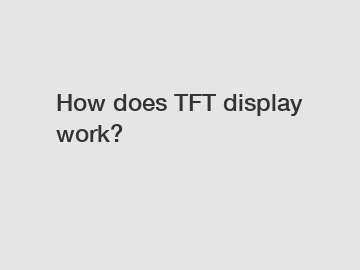How does TFT display work?
In today's fast-paced digital world, screens are an undeniable part of our daily lives. From smartphones to laptops, we rely on them for communication, information, and entertainment. Among the various display technologies available, TFT (Thin-Film Transistor) display undoubtedly stands out as one of the most widely used and revolutionary advancements. In this article, we will explore the inner workings of TFT display and delve into the fascinating details that make it an unparalleled technological marvel.
Demystifying TFT Display:
At its core, a TFT display is a type of liquid crystal display (LCD). The TFT technology revolutionized traditional LCD screens by incorporating individual transistors onto each pixel, resulting in superior image quality, enhanced color reproduction, and faster response times. Let's dive deeper into the components and functioning of TFT display.

1. The TFT Matrix:
To understand how TFT displays work, we must first comprehend the TFT matrix, which forms the backbone of the display. The matrix consists of tiny individual transistors embedded behind each pixel. These transistors control the amount of light passing through the liquid crystal layer, determining the color and intensity of each pixel.
2. Thin-Film Transistor (TFT):
TFTs are crucial components of the display's matrix and play a vital role in its functionality. They act as miniature switches, activating or deactivating the liquid crystal cells when a corresponding electrical charge is applied. TFTs are made up of a layer of semiconductor materials, typically amorphous silicon or polysilicon. Their ability to switch pixels on and off accurately and quickly is what enables TFT displays to deliver stunning and fluid visuals.
3. Liquid Crystals:
Liquid crystals reside between two layers of glass in a TFT display, forming a thin film. These liquid crystals are unique as they possess properties of both liquid and solid states. Their orientation can be controlled by the voltage applied via the TFTs, thus adjusting the amount of transmitted light. This controlled light transmission is what ultimately produces the images we see on the screen.
4. Color Filtering:
TFT displays typically utilize RGB (Red, Green, Blue) color filtering to produce a wide range of vibrant colors. Each pixel contains sub-pixels of these primary colors, with the TFT actively allowing or blocking light passing through each sub-pixel. By adjusting the intensity of each sub-pixel, a multitude of colors can be achieved, resulting in realistic and vivid displays.
5. Backlighting:
TFT displays incorporate a backlighting system placed behind the matrix to illuminate the screen uniformly. Earlier versions used CCFL (Cold Cathode Fluorescent Lamp), but modern TFT displays utilize LED (Light Emitting Diode) backlights for energy efficiency and improved color reproduction. The backlight illuminates the liquid crystal cells, which selectively block or transmit light, resulting in the desired image on the screen.
Advantages of TFT Display:
TFT displays offer numerous advantages that have solidified their dominance in the market:
1. Crystal-clear Visuals: The incorporation of TFT matrix and color filtering enables TFT displays to produce stunning images with exceptional clarity, sharpness, and high-resolution.
2. Wide Viewing Angles: TFT displays exhibit wide viewing angles, ensuring that the screen quality remains consistent even when viewed from various angles, making them ideal for multimedia use.
3. Fast Response Times: TFT display technology allows for swift pixel switching, resulting in minimal motion blur and ghosting, making these displays perfect for gaming and fast-paced videos.
5. Versatility: TFT displays can be manufactured in various sizes, allowing them to cater to a wide range of devices, from smartphones and tablets to TVs and computer monitors.
Conclusion:
The revolution brought about by TFT display technology has undoubtedly transformed the way we interact with digital screens. Its ability to deliver stunning visuals, exceptional color reproduction, and fast response times has set the benchmark for display technologies today. As we continue to witness advancements in TFT display technology, it's safe to say that they will remain a crucial element in our daily lives, providing immersive experiences for generations to come.
If you are looking for more details, kindly visit lcd light valve, 2.58 inch am oled china, 0.84 inch pm oled.


